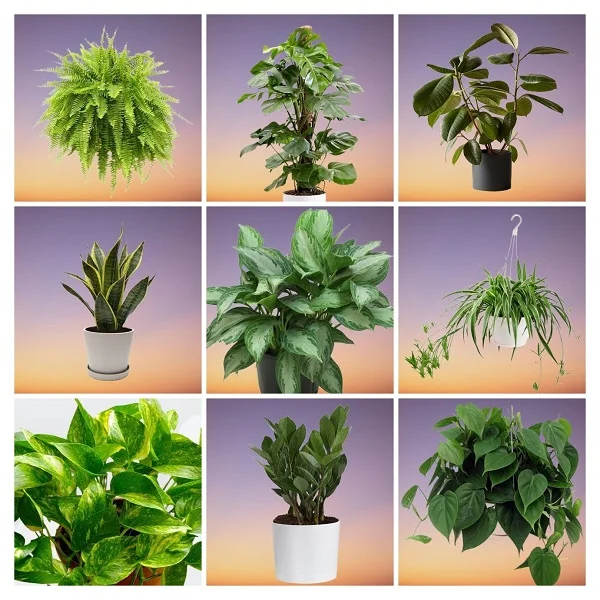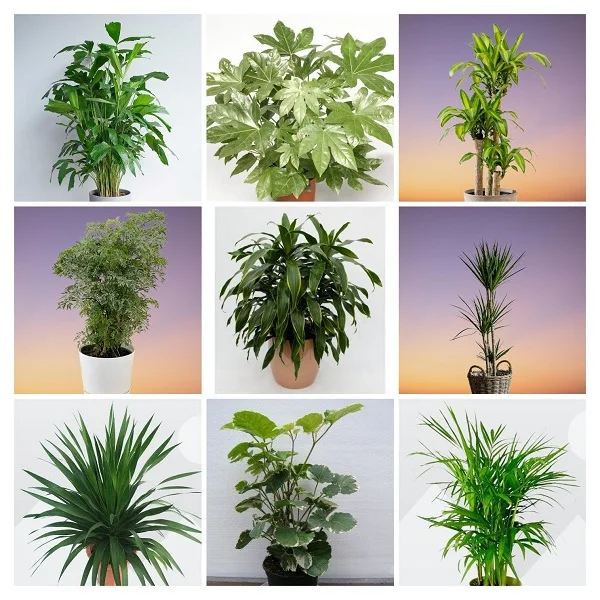30 Types of Tropical Foliage Plants that You can Grow Successfully in Any Space
Some links in this post may be affiliate links
Tropical foliage plants are popular magnificent plants that are grown for their spectacular leaves rather than for their flowers. They have their origins in the tropical regions of the world which are relatively wet, highly humid and consistently warm all the year through.
Tropical foliage plants are generally easy to grow when given growing conditions that mimick their natural habitat. Generally, these plants thrive in bright indirect light, warm and humid conditions and moist, well-drained soil that is rich in organic matter.
If you are looking to add these plants to your collection, we have herebelow outlined for you 30 tropical foliage plants that are popular for their colorful leaves and texture.
30 Tropical Leaf Plants for Indoors & Outdoors
Best tropical foliage plants are Monstera deliciosa, Pothos, Chinese Evergreens, Philodendrons, Rubber Plants, Areca Palm, Corn Plant, Calatheas, Maranta, Aglaonemas, Bird's Nest Bromeliads, Satin Pothos among others. Keep reading for the complete list.
1. Swiss Cheese Plant (Monstera deliciosa)

Swiss Cheese Plant also called Mexican bread fruit, windowleaf is one of the popular Monstera varieties on account of its large deeply perforated leaves, ability to adapt to a wide range of growing conditions and its ease of care even for a beginner.
Monstera deliciosa is a spectacular tropical foliage plant and is among the best bold statement plants for occupying the large empty spaces but requires a moss stick to support it to grow upright.
Monstera deliciosa prospers in medium to bright indirect light, warmth of 18-290C, humidity of 50-55% and moderately moist, fertile, well-drained Monsteras potting soil coupled with monthly feeding in the growing season.
Learn more on how to grow and care for Swiss Cheese Plant
2. Heartleaf Philodendron (Philodedron scandens)
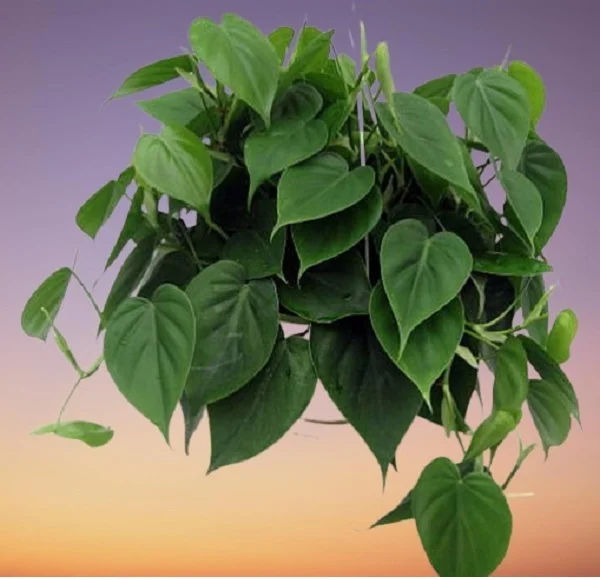
Heartleaf Philodedron or Sweetheart Plant is among the low-maintenance, climbing Philodendron plants varieties with air cleaning properties and is perfect for a table-top, a hanging basket, a pedestal, plant shelf, a trellis or a moss-pole.
On account of its magnificent foliage, Sweetheart Plant like Philodendron selloum (Lacy Tree Philodendron), Philodendron selloum 'Sun Red' and Philodendron 'Summer Glory' is among the best tropical foliage plants which will create a spectacular sight in any space.
Philodendron scandens flourishes in medium to bright indirect light, warmth of 18-260C, humidity of 50-55% and moderately moist, fertile, well-drained potting soils coupled with monthly feeding during the growing season.
Read more on how to grow and care for Heartleaf Philodendron
3. Pothos (Scindapsus aureus)
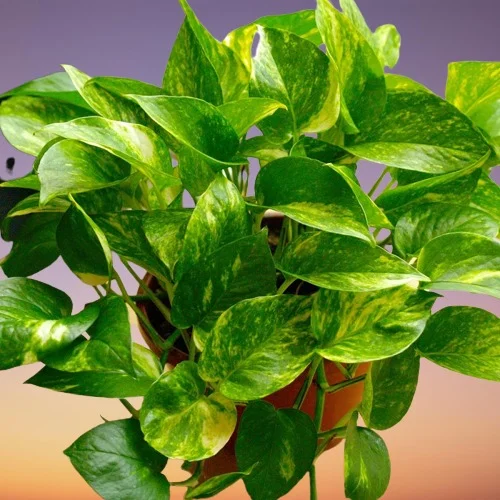
Pothos also called Devil's Ivy, Devil's Vine or Money Plant is among the popular Pothos varieties and is perfect for a hanging basket, tabletop, desktop, shelf, moss pole or trellis making it ideal for the limited spaces.
Scindapsus aureus also called Epipremnum aureum are low maintenance plants with air cleaning properties which get rid of xylene, toulene, benzene, formaldehyde and ammonia from indoor air.
Scindapsus aureus thrives in medium to bright indirect light (filtered light), warmth of 18-290C, humidity of 50-55% and moderately moist, rich, well-drained Pothos potting soil coupled with monthly feeding in the growing season.
Learn more on how to grow and care for Scindapsus aureus Pothos
4. Rubber Plant (Ficus elastica)
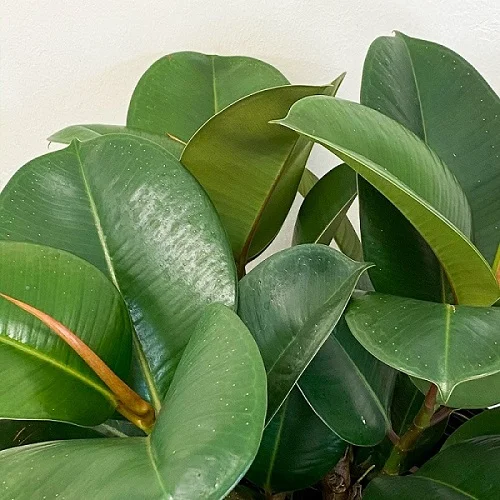
Rubber Plants also called Rubber Fig, Rubber Tree, Rubber Bush, Indian Rubber Tree or Indian Rubber Bush are some of the popular Ficus elastica varieties with large, decorative leaves and air-cleaning properties which readily adapt to a wide range of growing conditions.
These tropical foliage plants grow to a height of 6-10 feet which places them among the best tree-like plants and perfect for occupying the large spaces.
Ficus elastica prospers in bright light with 4-6 hours of direct sunshine, warmth of 15-280C, humidity of 50-55% and moderately moist, fertile, well-drained potting soil coupled with monthly feeding in the growing season.
Read more on how to grow and care for Rubber Plants
5. Corn Palm (Dracaena fragrans)
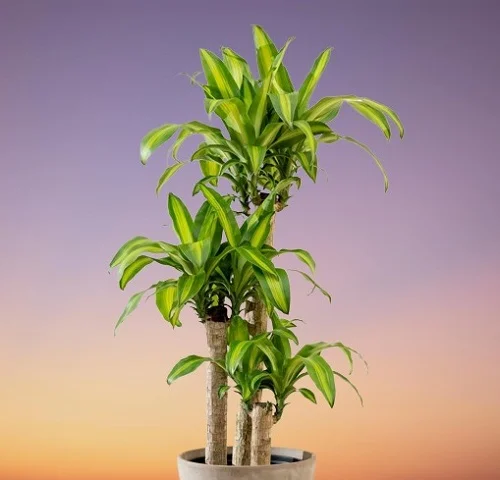
Corn Palm also called Corn Plant, Striped Dracaena or Compact Dracaena is among the popular Dracaena varieties on account of its glossy, large, yellow-striped leaves which will brighten up any space in the home and ability to adapt to a wide range of growing conditions.
Striped Dracaena is a large tropical plant which grows to a height of 6 feet and about 2 feet wide making it one of the best large low-light plants for the living room as it will make a bold statement in any space.
.Dracaena fragrans grows best in bright indirect light (dappled light), warmth of 16-280C, humidity of 50-55% and consistently moist, fertile, well-drained, all purpose soil coupled with monthly feeding during the growing season.
Learn more on how to grow and care for Dracaena fragrans
6. Lady Palm (Rhapis excelsa)
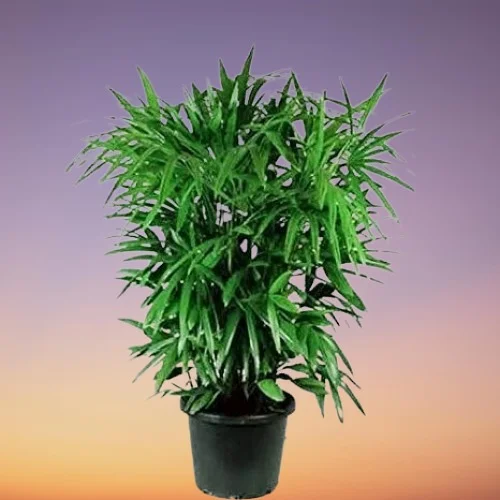
Lady Palm is one of the popular palms and grows in multi-stemmed clumps with numerous, glossy, evergreen leaves divided into broad, ribbed segments.
Lady Palm like Areca Palm (Dypsis lutescens), Fishtail Palm (Caryota mitis) and Pygmy Date Palm (Phoenix roebelenii) are attractive foliage plants that will create a delightful spectacle in any space.
Rhapis excelsa thrives in bright to medium indirect light, warmth of 16-270C, humidity of 50-55% and moderately moist, fertile, well-drained soil coupled with monthly feeding during the growing season.
Read more on how to grow and care for Lady Palm
7. Snake Plants (Dracaena trifasciata)

Snake Plants also called Mother in-law's Tongue, Devil's Tongue, Jinn's Tongue, Bow String Hemp or Snake Tongue are among the hard to kill plants due to their ability to withstand low light, dry air, drafts and long periods without being watered.
Mother in-law's Tongue are popular Sanseviera varieties reknowned for their air cleaning properties based on their ability to increase oxygen concentration in the air.
Dracaena trifasciata blossom in bright light with 6-8 hours of direct sunlight, warmth of 16-290C, humidity of 50-55% and moderately moist, loose, fertile succulents soil coupled with monthly feeding during the growing season.
Learn more on how to grow and care for Dracaena trifasciata
8. Chinese Evergreens (Aglaonema)

Chinese Evergreens are popular foliage plants on account of their compact size, spectacular foliage, ease of care, air cleaning properties and ability to adapt to wide range of growing conditions.
The popular Aglaonema varieties are Aglaonema modestum, Aglaonema silver queen, Aglaonema pseudobracteatum (Golden Evergreen), Aglaonema commutatum, Aglaonema nitidum and Aglaonema pictum among many others.
Aglaonemas grow best in medium to bright light (dappled light), warmth of 18-270C, humidity of 50-55% and moderately moist, well-drained soils that are rich in organic matter coupled with feeding every 3-4 months in the growing season.
Read more on how to grow and care for Chinese Evergreens
9. Bird's Nest Bromeliads (Nidularium Bromeliads)

Nidularium Bromeliads are popular Bromeliad varieties with a central rosette of very short saw-edged leaves (Bird's nest) which turns bright red at flowering time and 1 foot long leaves below the bird's nest.
The popular varieties of Bird's Nest Bromeliads are Nidularium fulgens, Nidularium innocentii and Nidularium innocentii striatum. Nidularium Bromeliads differ from the Neoregelia Bromeliads (Blushing Bromeliads) in that they have a central rosette of very, short, saw-edged leaves (Bird's nest) which turns bright-red at flowering time.
Bird's Nest Bromeliads flourish in bright indirect light (filtered light), warmth of 18-280C, humidity of 60-70% and consistently moist, rich, well-drained orchids potting soil coupled with fortnightly feeding in the growing season.
Learn more on how to grow and care for Bird's Nest Bromeliads
10. Calathea Network (Calathea musaica)
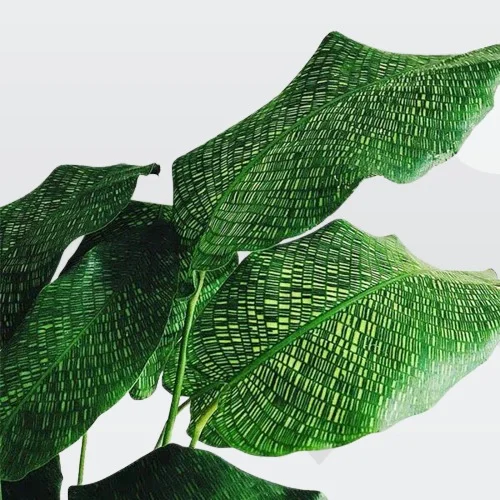
Calathea Network also called Network Prayer Plant is among the popular Calathea varieties with green, arching, glossy leaves adorned by a criss-crossing (mosaic) pattern giving it the common name, 'Calathea Network'.
Network Prayer Plant like Goeppertia warscewiczii (Calathea Jungle Velvet), Goeppertia zebrina (Zebra Calathea), Calathea veitchiana (Calathea Medallion) and Calathea vittata (Goeppertia elliptica) are popular tropical foliage plants with highly decorative leaves which close at night and look like praying hands giving these plants the name, 'prayer plants'.
Calathea musaica prospers in bright indirect light (filtered light), warmth of 18-280C, humidity of 70-80% and moderately moist, fertile, well-drained potting soil coupled with monthly feeding in the growing season.
Read more on how to grow and care for Calathea Network
11. Dwarf Umbrella Tree (Schefflera arboricola)

Dwarf Umbrella Tree also called Hawaiian Schefflera or Dwarf Schefflera is among the fast-growing plants with a high tolerance to neglect and easily adapts to a wide range of growing conditions.
Dwarf Schefflera is much easier to grow than its relative Schefflera actinophylla (Umbrella Tree) and will happily grow as a bush if the growing tip is removed.
Schefflera arboricola flourishes in medium to bright indirect light, warmth of 16-280C, humidity of 50-55% and moderately moist, rich, well-drained soil coupled with monthly feeding during the growing season.
Read more on how to grow and care for Dwarf Umbrella Tree
12. Ti Plant (Cordyline terminalis)

Ti Plant also called Hawaiian Goodluck Plant, Hawaiian Ti Plant, Polynesian Ti is one of the popular purple-leaved plants that is ideal for adding a splash of color among the greenery and is also believed to bring good luck.
There are many varieties of Hawaiian Goodluck Plant where Rededge which has green leaves streaked with red is the favorite one. Others are tricolor, Prince Albert, Firebrand, Amabilis, Baptistii, Kiwi and Atom among others.
Cordyline terminalis blossoms in bright indirect light (filtered light), warmth of 18-290C, humidity of 50-55% and moderately moist, fertile, well-drained potting soil coupled with monthly feeding in the growing season.
Learn more on how to grow and care for Ti Plant
13. ZZ Plant (Zamioculcas zamiifolia)
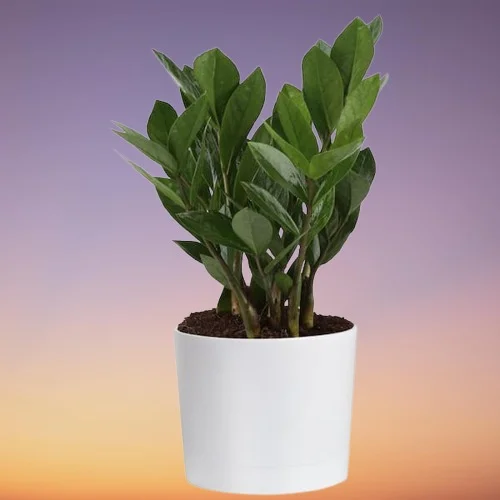
ZZ Plant also called Zanzibar Gem, Zuzu Plant, Aroid Palm or Emerald Palm is a highly tolerant plant with attractive glossy foliage and is one of the popular plants for limited spaces.
The foliage in Zuzu Plant contains unusually high content of water up to 90% and has an individual leaf longevity of at least 6 months. These enable it to survive extremely well under interior low light levels for up to 4 months without being waterered making it one of the best drought-tolerant plants.
Zamioculcas zamiifolia prospers in bright indirect light (partial shade), warmth of 15-260C, humidity of 50-55% and moderately moist, fertile succulents potting soil coupled with monthly feeding during the growing season.
Learn more on how to grow and care for ZZ Plant
14. Weeping Fig (Ficus benjamina)
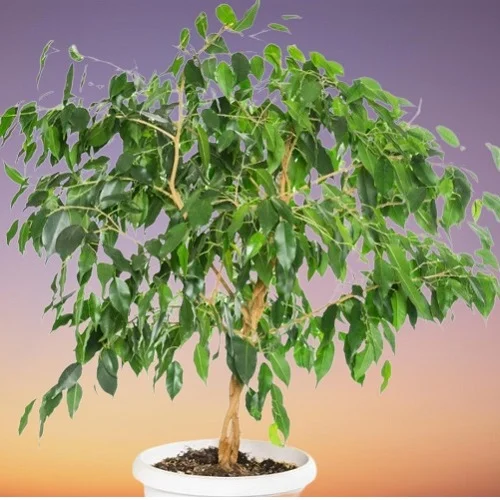
Weeping Fig is a popular tree-like foliage plant due to its elegant growth and tolerance to poor growing conditions but it does not like sudden changes in light conditions.
Weeping Fig like many Ficus varieties is reknowned for its air cleaning properties and is effective in cleaning the indoor air of xylene, toulene and trichloroethylene.
Ficus benjamina thrives in bright light with 4-6 hours of direct sunshine, warmth of 16-270C, humidity of 50-55% and moderately moist, fertile, well-drained potting mix coupled with monthly feeding during the growing season.
Read more on how to grow and care for Weeping Fig
15. Crystal Anthurium (Anthurium crystallinum)
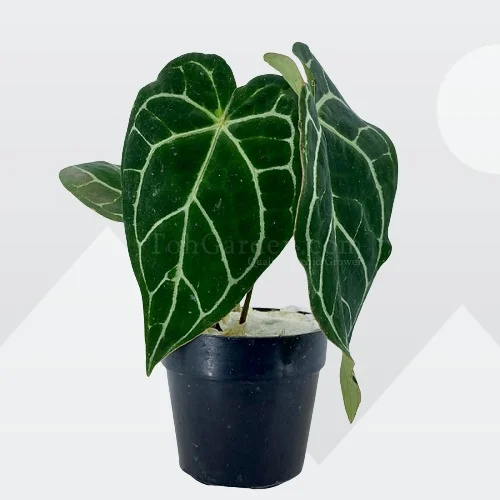
Crystal Anthurium is one of the popular Anthurium varieties whose heart-shaped leaves are velvety on the surface and the leaf color changes from bronzy-purple to deep-green with age.
Anthurium crystallinum is often mistaken for Anthurium clarinervium and Anthurium magnificum both of which look similar though they differ in size and leaf presentation.
Anthurium crystallinum blossoms in bright indirect light, warmth of 16-270C, humidity of 60-80% and consistently moist, fertile, well-drained potting soils coupled with monthly feeding during the growing season.
Learn more on how to grow and care for Crystal Anthurium
16. Alocasia longiloba
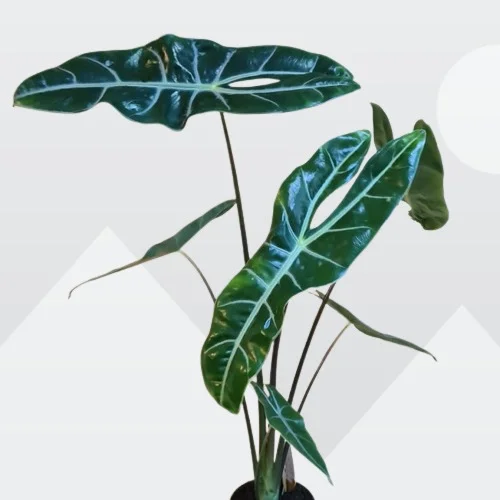
Alocasia longiloba is among the sought-after Alocasia varieties with large, arrow-shaped, bluish-green leaves with silver margins and veining and light-green or purple undersides and are held on mottled brown leaf stalks.
On account of their spectacular foliage, Alocasia longiloba, Alocasia x amazonica 'Polly' (Alocasia Polly), Alocasia zebrina (Zebra Elephant Ear Plant) and Alocasia micholitziana (Green Velvet Alocasia) are popular tropical foliage plants great for any plant collection for a touch of an exotic feel.
Alocasia longiloba thrives in bright indirect light, warmth of 18-250C, humidity of 60-70% and moderately moist, fertile, well-drained soils in addition to monthly feeding in the growing season.
Read more on how to grow and care for Alocasia longiloba
17. Begonia rex (Painted-leaf Begonia)
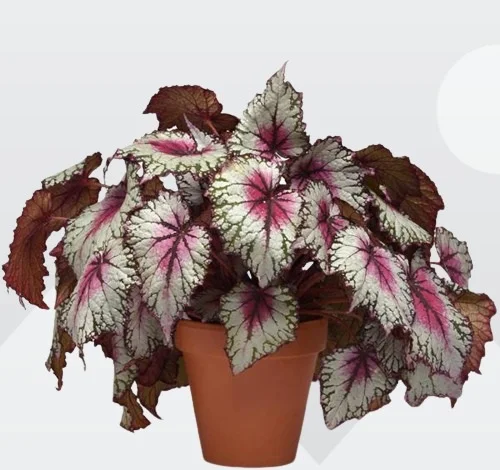
Painted-leaf Begonia also called Fancy Leaf Begonia is among the popular Begonia varieties and bears large, lop-sided leaves occuring in various hues which may be mixes of greens, silver, white, reds, pinks, yellow, purple, orange, maroon and others.
Fancy Leaf Begonia like Begonia Lucerna is favored for its spectacular foliage. It has a clumping growth habit with the foliage tightly packed together. The leaves arise from rhizomes and may be ruffled, puckered, spotted, streaked, waxy, smooth and so on.
Begonia Rex thrives in bright indirect light with 4-6 hours of sunshine, warmth of 18-260C, humidity of 60-70% and moderately moist, rich, well-drained soil coupled with fortnightly feeding during the growing season.
Learn more on how to grow and care for Begonia rex
18. Satin Pothos (Scindapsus pictus)
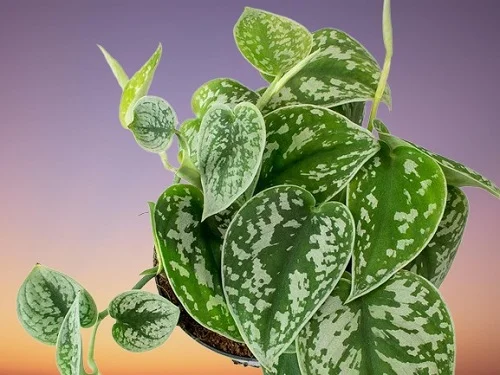
Scindapsus pictus also called Satin Pothos, Silver Pothos or Silver Philodendron are evergreen climbing plants which bear matte green leaves covered in silver blotches with a satin sheen.
There are many varieties of Scindapsus pictus with spectacular variegations which make these plants some of the best tropical foliage plants for the home, office and other spaces.
Silver Vines blossom in medium to bright indirect light (filtered light), warmth of 15-290C, humidity of 50-55% and moderately moist, fertile, well-drained soil coupled with monthly feeding during the growing season.
Read more on how to grow and care for Scindapsus pictus Pothos
19. Arrowhead Vines (Syngonium podophyllum)
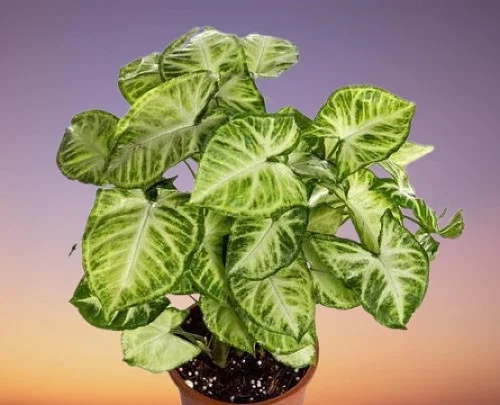
Arrowhead Vine also called Goosefoot Vine, Arrowhead Plant, African Evergreen, Arrowhead Philodendron, American Evergreen or Nephthytis is a popular foliage plant whose leaves dramatically change in shape as the plant ages.
Many Syngonium varieties are available where the main difference is in the position and extent of the cream or white markings. Some leaves are almost entirely white, pink or yellow.
Syngonium podophyllum prospers in bright indirect light, warmth of 15-280C, humidity of 50-55% and consistently moist, fertile, well-drained potting soils coupled with monthly feeding during the growing season.
Learn more on how to grow and care for Arrowhead Vines
20. Maranta Plant (Maranta leuconeura)
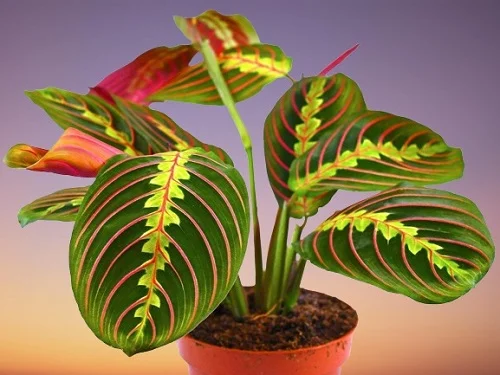
Maranta leuconeura are popular, low-growing, foliage plants with long leaves known for their curious habit of folding and raising at night and hence their common name, Prayer Plant.
Many varieties and cultivars of Maranta Plants are available which include Maranta tricolor (Herringbone Plant) with prominent red leaf veins, Maranta leuconeura kerchoveana (Rabbit's Tracks) with brown leaf blotches which turn green with age and Maranta leuconeura massangeana with blackish green leaves and silvery veins among others.
Maranta Plants grow best in partial light, warmth of 16-280C, humidity of 60-80% and consistently moist, fertile, well-drained soil coupled with monthly feeding during the growing season.
Read more on how to grow and care for Maranta leuconeura
21. Bird's Nest Fern (Asplenium nidus)

Bird's Nest Fern or Asplenium Fern is a large, bold, foliage plant beautiful enough to be displayed as a focal point plant in a large space.
Due to its affinity for high moisture, Asplenium Fern is one of the best plants for a closed terrarium where the magnificient green leaves are a sight to behold inside a terrarium.
Asplenium nidus flourishes in bright indirect light, warmth of 15-250C, humidity of 60-70% and consistently moist, rich, well drained potting soils coupled with monthly feeding during the growing season.
Learn more on how to grow and care for Bird's Nest Fern
22. Small-leaf Spiderwort (Tradescantia fluminensis)
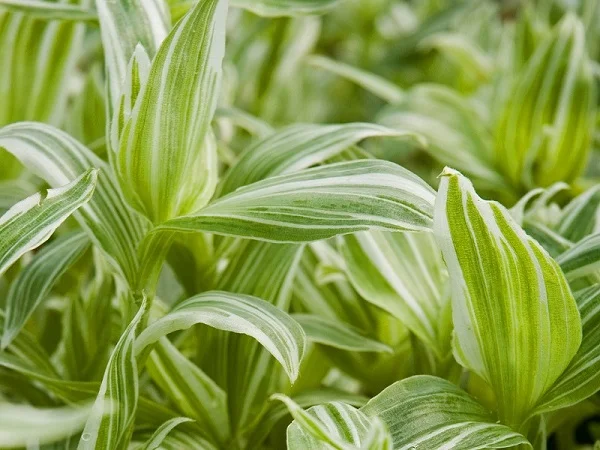
Small-leaf Spiderwort also called Wandering Trad, Inch Plant, River Spiderwort or Wandering Willie is one of the popular Tradescantia varieties and is easy to grow even for a beginner as it easily adapts to a wide range of growing conditions.
Wandering Trad and Baby Bunny Bellies Plant (Tradescantia chrysophylla) are great for a hanging basket, pedestal, table-top, desktop or shelf where the stems can cascade downwards beautifully.
Tradescantia fluminensis thrives in bright indirect light, warmth of 16-270C, humidity of 50-55% and consistently moist, fertile, well-drained soil coupled with fortnightly feeding during the growing season.
Read more on how to grow and care for Small-leaf Spiderwort
23. Pepper Face Plant (Peperomia obtusifolia)
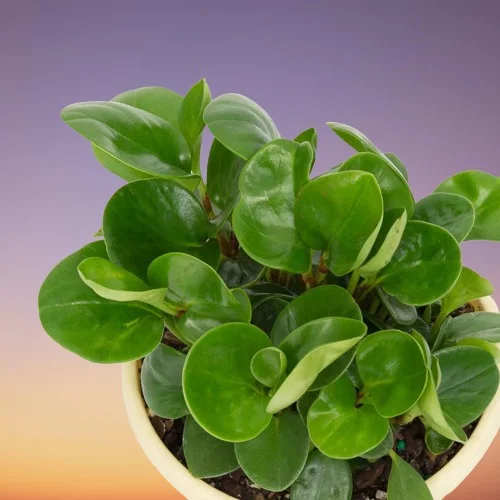
Pepper Face Plant also called Baby Rubber Plant or American Rubber Plant is one of the compact, upright-growing Peperomia varieties and bears cupped leathery leaves which resembles a rubber plant.
Baby Rubber Plant like Wax Privet Peperomia (Peperomia glabella), Watermelon Peperomia (Peperomia argyreia) and Peperomia Ginny (Peperomia clusiifolia) are magnificent tropical foliage plants that grow successfully in any space.
Peperomia obtusifolia requires bright indirect light, warmth of 18-250C, humidity of 50-55% and moderately moist, rich, well-drained potting soil coupled with monthly feeding in the growing season.
Learn more on how to grow and care for Pepper Face Plant
24. Rhaphidophora tetrasperma
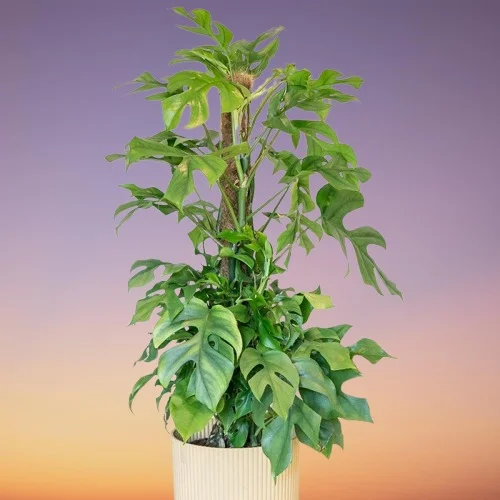
Rhaphidophora tetrasperma, often incorrectly labelled as Mini Monstera, is an evergreen vine which bears heart-shapes leaves with split lobes and trailing stems and is spectacular on a trellis or a moss pole..
You may find it mislabelled as a Monstera deliciosa or an Epipremnum pinnatum. However, Rhaphidophora tetrasperma belongs to the genus Rhaphidophora which comprises of about 100 species.
Rhaphidophora tetrasperma flourishes in bright indirect light, warmth of 16-270C, humidity of 50-60% and moderately moist, fertile, well drained soil coupled with monthly feeding during the growing season.
Read more on how to grow and care for Rhaphidophora tetrasperma
25. String of Pearls Plant (Senecio rowleyanus)
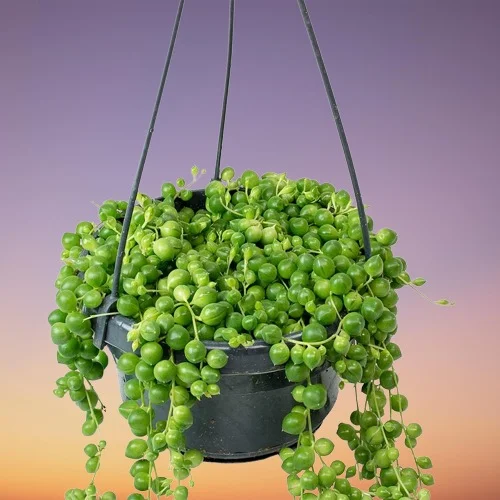
String of Pearls Plant or String of Beads Plant is among the popular Senecio varieties with pendant thread-like stems on which spherical, green leaves grow making it resemble a neck-lace of beads or pearls, hence the common names.
String of Pearls Plant grows as a trailer, with stems trailing on the ground, rooting where they touch and forming dense mats which places it among the best plants for hanging baskets.
Senecio rowleyanus thrives in bright light with 6-8 hours of direct sunshine, warmth of 20-270C, humidity of 50-55% and moderately moist, fertile, well-drained succulents potting soil coupled with monthly feeding during the growing season.
Learn more on how to grow and care for String of Pearls Plant
26. String of Nickels Plant (Dischidia nummularia)
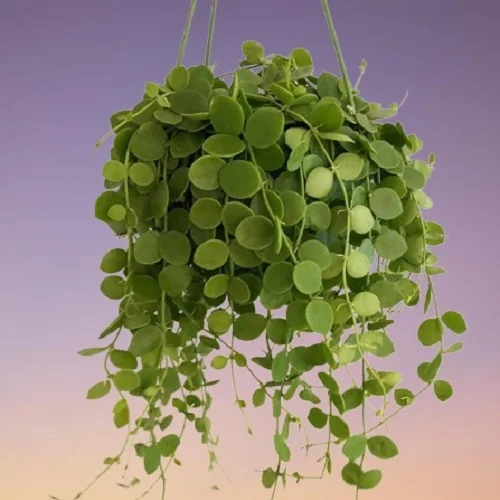
String of Nickels Plant also called Button Orchid is one of the trailing succulent plants with trailing atems and succulent leaves which form a dense mass of greenish-yellow foliage.
The stems can grow upto 3 metres long which places Button Orchid among the popular string of plants that are ideal for a hanging basket, table-top, pedestal, plant shelf and other limited spaces.
Dischidia nummularia prospers in bright light with 4-6 hours of morning sunshine, warmth of 18-260C, humidity of 50-55% and moderately moist, rich, well-drained, succulents potting mix with two feedings during the growing season.
Read more on how to grow and care for String of Nickels Plant
27. Jade Plant (Crassula ovata)
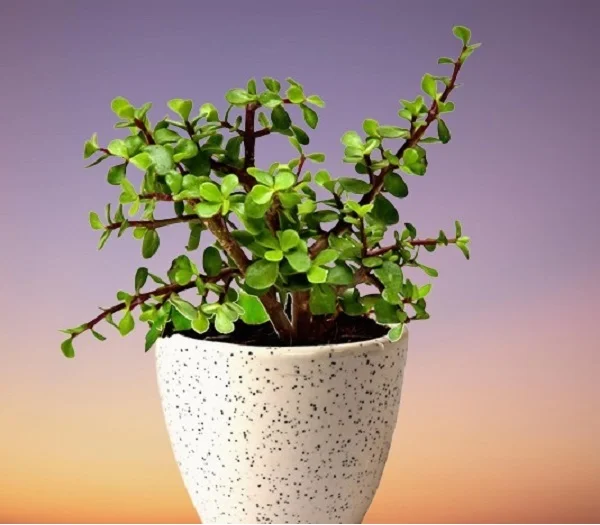
Jade Plant is one of the best succulent plants that will withstand a great deal of neglect and mismanagement making it easy to grow even for a beginner as it can survive a considerable period of time without being watered.
Jade Plant, Propeller Plant (Crassula falcata) and Crassula dubia (Crassula cotyledonis) are some of the popular Crassula varieties grown for their magnificent foliage and will add beauty in any space.
Crassula ovata thrives in bright light with 4-6 hours of direct sunlight, warmth of 15-260C , humidity of 50-55% and moderately moist, rich, well-drained succulents soil coupled with monthly feeding during the growing season.
Learn more on how to grow and care for Jade Plant
28. Kalanchoe marmorata (Pen Wiper Plant)
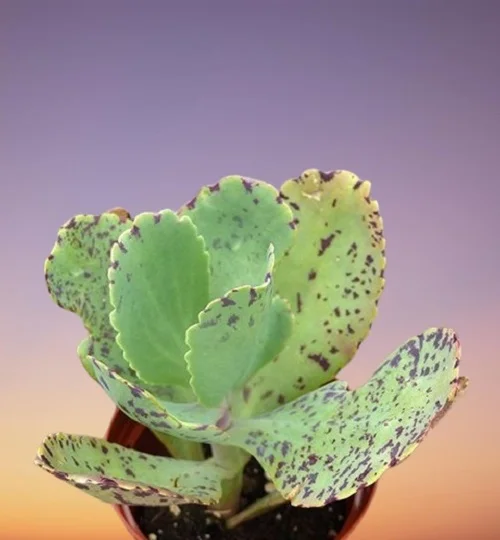
Penwiper Plant is one of the popular foliage Kalanchoe plants varieties grown for its large scalloped and brown-blotched leaves.
On account of their compact size, Penwiper Plant and its cousins Kalanchoe thyrsiflora (Paddle Plant) and Kalanchoe tomentosa (Panda Plant) are among the best plants for the limited spaces.
Kalanchoe marmorata floursihes in bright light to full sunlight, warmth of 16-260C, humidity of 50-55% and moderately moist, fertile, well-drained succulents potting soil coupled with monthly feeding during the growing season.
Read more on how to grow and care for Penwiper Plant
29. Stromanthe Triostar (Stromanthe sanguinea)
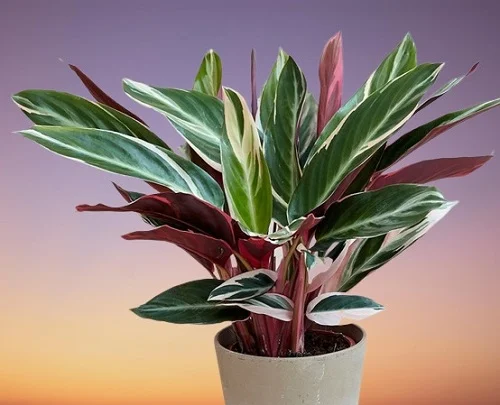
Stromanthe triostar also called Triostar Stromanthe or Tricolor Prayer Plant is a herbaceous perennial plant with strikingly beautiful foliage making it one of the best plants for the living room for a great first impression.
The Triostar Stromanthe is native to the tropical regions of the Americas from Mexico to Trinidad to northern Argentina. It is non-toxic to both humans and pets.
Stromanthe sanguinea thrives in bright indirect light (dappled light), warmth of 16-260C, humidity of 60-80% and consistently moist, fertile, well-drained potting soil coupled with monthly feeding during the growing season.
Learn more on how to grow and care for Stromanthe Triostar
30. Purple waffle Plant (Hemigraphis alternata)
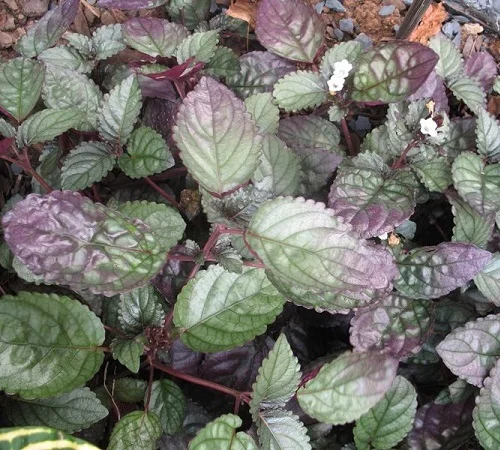
Purple Waffle Plant also called Red Flame Ivy, Metal Leaf Plant or Red Ivy is a climbing plant whose leaves are silvery in the shade and metallic purple when grown under some direct sunshine.
Red Flame Ivy along with Persian Shield Plant (Strobilanthes dyerianus) and Purple Passion Plant (Gynura) are some of the popular purple-leafed plants that will add a splash of colour in any plant collection.
Hemigraphis alternata blossoms in bright light with 4-6 hours of direct sunshine, warmth of 18-270C, humidity of 55-65% and consistently moist, rich, well-drained soils coupled with fortnightly feeding in the growing season.
Read more on how to grow and care for Purple waffle Plant
